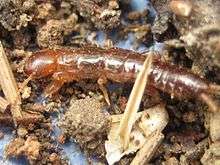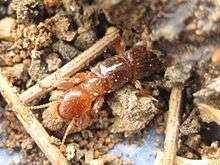Oligotomidae
Oligotomidae is a family of webspinners in the order Embioptera. There are about 6 genera and at least 40 described species in Oligotomidae.[1][2][3][4]

Haploembia solieri
| Oligotomidae | |
|---|---|
 | |
| Haploembia solieri | |
| Scientific classification | |
| Kingdom: | Animalia |
| Phylum: | Arthropoda |
| Class: | Insecta |
| Order: | Embioptera |
| Family: | Oligotomidae |
They are known to be found in warmer regions of the Old World and in the Southwestern United States.[5]
Genera
These six genera belong to the family Oligotomidae:[2][3][4]
- Aposthonia Krauss, 1911
- Aposthonia ceylonica, native to South-East Asia, found to be present in the UK in 2019.[6]
- Bulbosembia, Ross, 2007
- Eosembia, Ross, 2007
- Haploembia Verhoeff, 1904
- Lobosembia, Ross, 2007
- Oligotoma Westwood, 1837
gollark: Using similar maths to GPS you can track the source of an outgoing modem broadcast using 4 modems.
gollark: Not necessarily.
gollark: You can actually quite easily track down the location of a GPS server (they broadcast it after all) so you could automatically nuke any GPS.
gollark: Oddly, yes.
gollark: Perhaps make waitForAny/all return "bundles" instead?
References
- "Oligotomidae Family Information". BugGuide.net. Retrieved 2018-03-05.
- "Oligotomidae Report". Integrated Taxonomic Information System. Retrieved 2018-03-05.
- "Oligotomidae Overview". Encyclopedia of Life. Retrieved 2018-03-05.
- "Browse Oligotomidae". Catalogue of Life. Retrieved 2018-03-05.
- Eric Tentarelli (2012). A Guide to Insects. Blackwell. p. 263.
- Briggs, Helen (27 February 2019). "Webspinners: New order of insects sets up home in UK". BBC News. British Broadcasting Corporation. Retrieved 2 March 2019.
Further reading
- Arnett, Ross H. Jr. (2000). American Insects: A Handbook of the Insects of America North of Mexico. 2nd Edition. CRC Press. ISBN 0-8493-0212-9.
- Borror, Donald J.; Peterson, Roger Tory; White, Richard E. (1998). A Field Guide to Insects. Houghton Mifflin. ISBN 978-0395911709.
- Gillott, Cedric (1980). Entomology. Plenum Press. ISBN 0-306-40366-8.
- Kellogg, Vernon L. (1905). American insects. H. Holt.
- Maehr, M.D.; Eades, D.C. (2013). "Embioptera Species File Online, Version 5.0". Retrieved 2018-03-05.
- Majka, C. (2009). "Thomas L. Casey and Rhode Island". ZooKeys (22): 267. doi:10.3897/zookeys.22.93.
- Misof, B.; Liu, S.; Meusemann, K.; Peters, R.S.; et al. (2014). "Phylogenomics resolves the timing and pattern of insect evolution". Science. 346 (6210): 763. doi:10.1126/science.1257570. PMID 25378627.
- Ross, Edward S. (1984). "A synopsis of the Embiidina of the United States". Proceedings of the Entomological Society of Washington. 86 (1): 82–93. ISBN 90-5782-035-8.
- Ross, Edward S. (1970). "Biosystematics of the Embioptera". Annual Review of Entomology. 15 (1): 157–172. doi:10.1146/annurev.en.15.010170.001105.
- Ross, Edward S. (1944). "A revision of the Embioptera, or web-spinners, of the New World". Proceedings of the United States National Museum. 94 (3175): 401. doi:10.5479/si.00963801.94-3175.401.
- Szumik, Claudia A. (1996). "The higher classification of the order Embioptera: a cladistic analysis". Cladistics. 12 (1): 41–64. doi:10.1111/j.1096-0031.1996.tb00192.x.
This article is issued from Wikipedia. The text is licensed under Creative Commons - Attribution - Sharealike. Additional terms may apply for the media files.